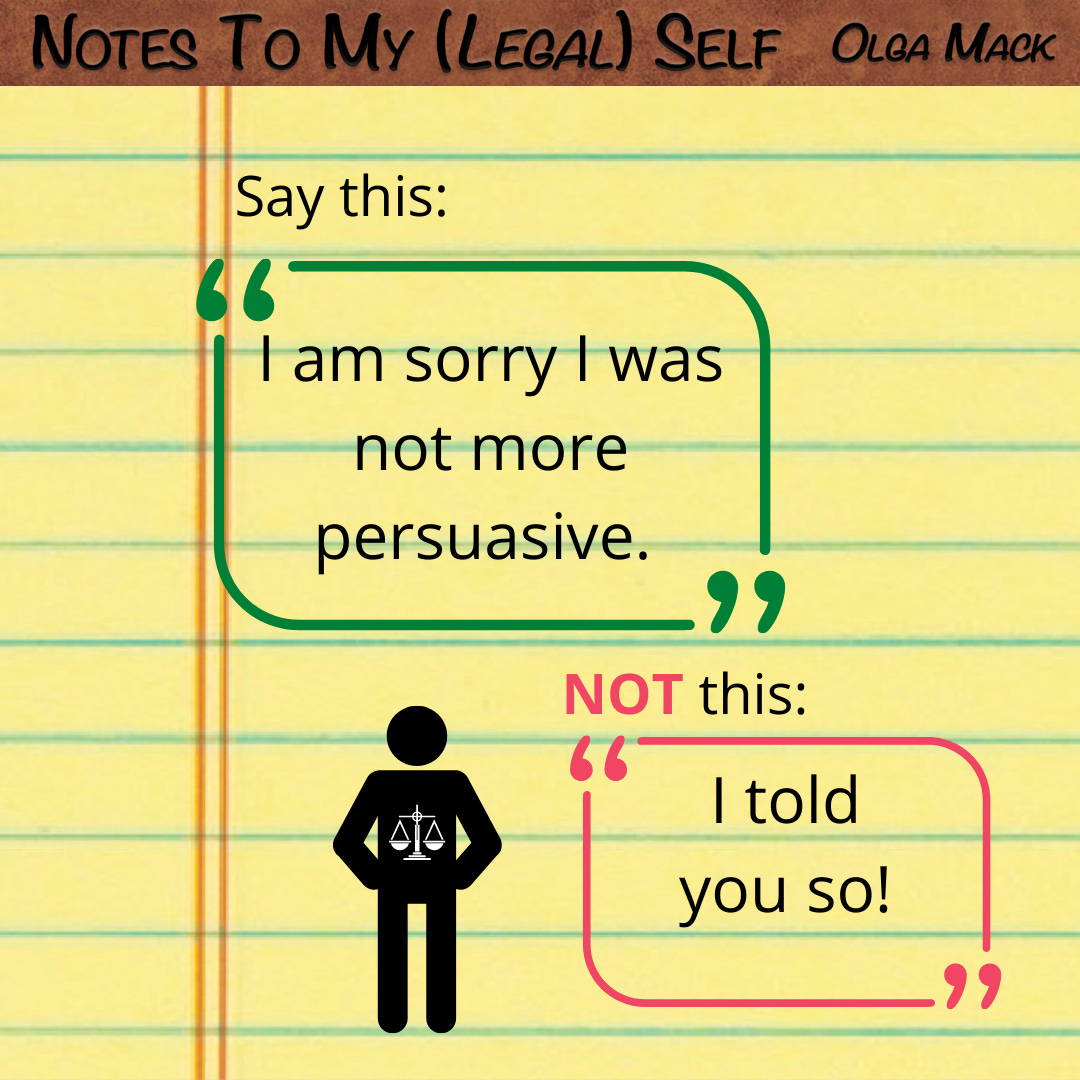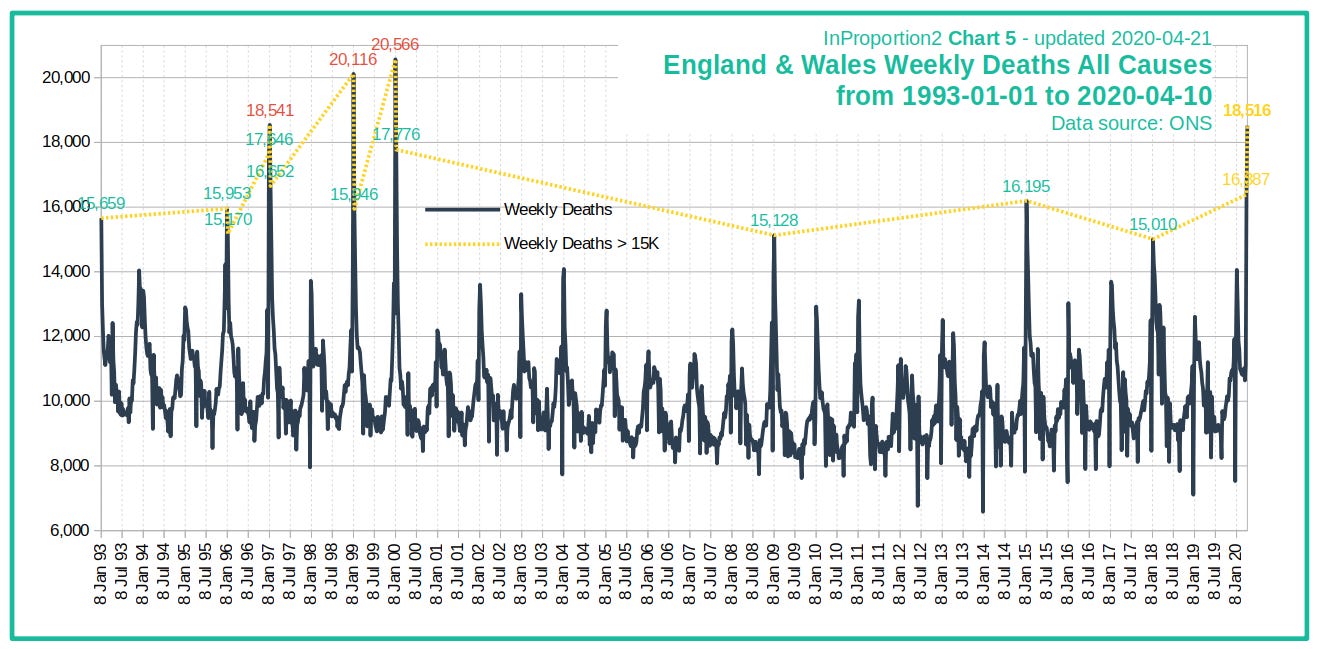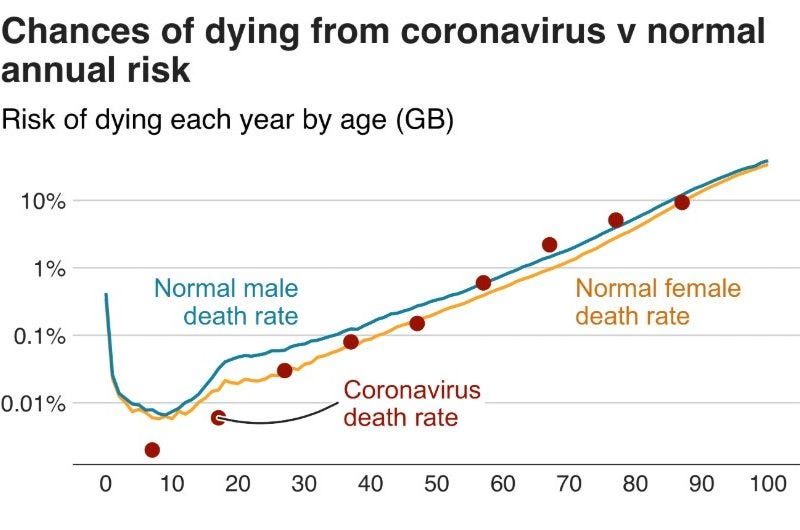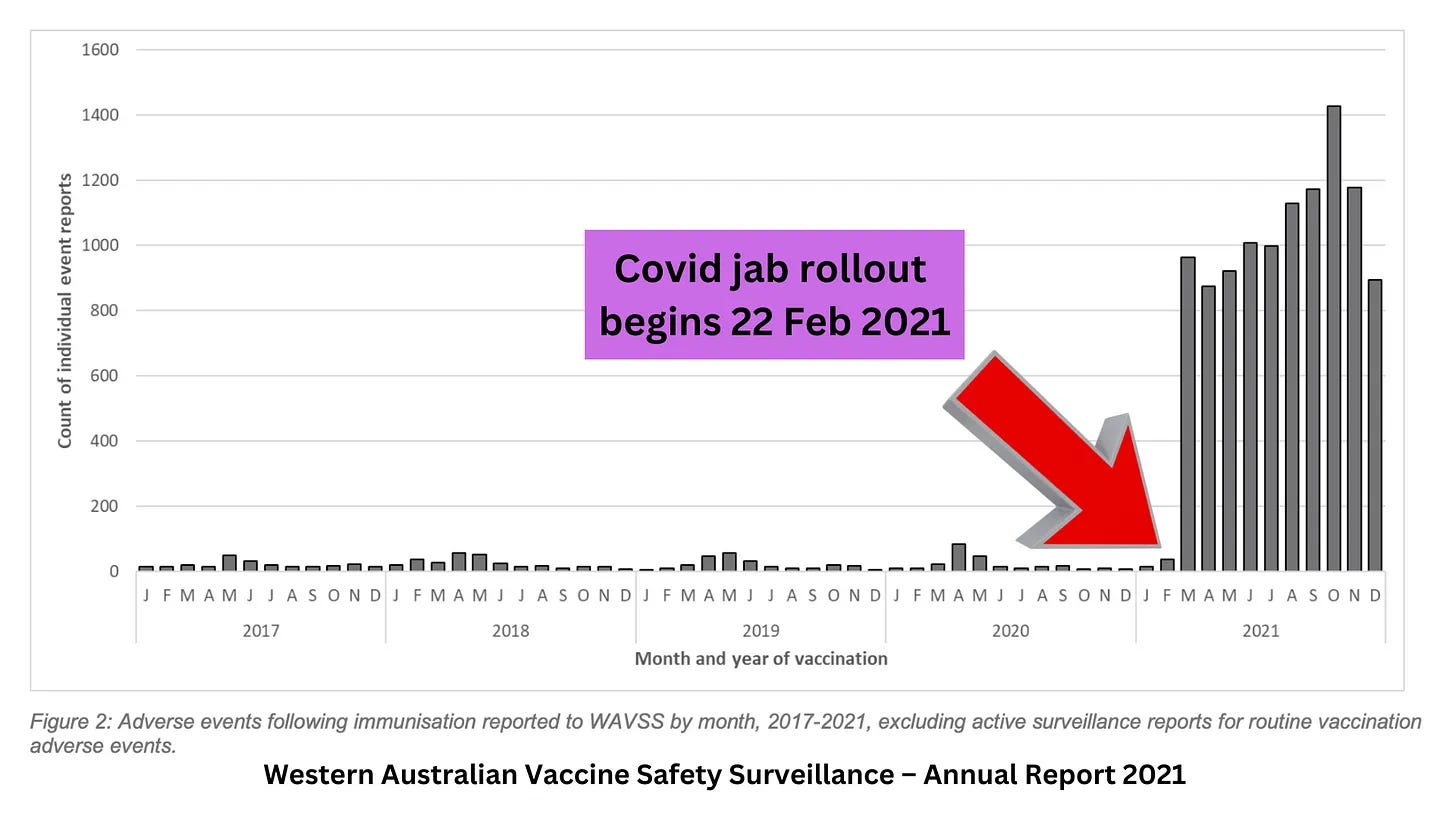More Ammo: Remember "Flattening the Curve" - March 2020?
You can imagine how much I hate to say "I told you so ..."! ;-)
Here is an article which contains some useful links, which I wrote with the aim of “waking up” a friend, in the “two weeks to flatten the curve” in 2020 (March). Some are informative, some amusing, some old hat to you now, some revelatory if you haven’t come across them before.
It’s interesting to look back and see how one was thinking when this mess first started.
The question uppermost in my mind was
“is this another rehearsal - (like “swine flu” or the H1N1 flap) - or the real thing?
I had been hoping that it would be after my lifetime, but when it transpired that it was the “medical martial law” that James Corbett had predicted in 2009, I realised that I should be pleased that it had happened during my lifetime, as there was some chance I could help my offspring understand what was going on, as there is no way that most people can know enough modern history to be able to pick up on what was happening. I had been very fortunate, which meant - unlike most people - I had had time to move to a warmer climate, buy a smallholding with off-grid potential, and get some trees growing.
(They say the best time to plant a tree is always …
20 years ago)!
(I only managed 10).
So when “lockdowns” were first perpetrated, I was watching the politicians and epidemiologists carefully for signs of rehearsal or commitment.
During the first weeks of the lockdown it became apparent that one of the major points of divergence in thinking was that either the notion that
you could stop the spread of the virus, if you just tried hard enough; or
a respiratory virus is going to spread whatever you do (although you might slow it down a little).
When I heard the former view expressed or implied, my instinct was the latter - surely everybody is going to meet the virus sooner or later, whatever you do?
That is one of the issues that this article may shed a little light on - both the spread or lack of, and the thinking about it, which was - or could have been - going on at the start of the “pandemic”.
The body of this is an email that I sent to a friend. My missus (xxxxxx) (remember “kisses for the missus” to keep track) had replied to a comment on the Facebook page of a friend called yyyyyyy, expressing a different point of view; a mutual friend (zzzzzz) then weighed in on the other side, and I thought the issue was important and worth giving a carefully considered response. Rather than put it on Facebook for people of all stances and aptitudes to read, we decided that an email tailored to our intelligent, skeptical, but mainstream-thinking friend (zzzzzz) would be better. It also helped to stimulate and structure my thinking.
I started writing the email during the initial “2 or 3 weeks …” (depending on where you were) “… to flatten the curve”, but it grew and took me a couple of weeks to write.
I hope you find something useful or amusing, on
pandemics
epidemiology
respiratory virus spread
(recent) historical background
etc.
======================================================================
March 2020
Hi zzzzzz,
I hope you two are well and thriving.
Here is a response to your answers to xxxxxx's comments on yyyyyy's Facebook page. (We were going to reply on that page, but have decided against it).
Best wishes
Jonathan and xxxxxx
_________________________________________________________
Your response has the brevity ("the soul of wit") and succinctness appropriate to a Facebook post. The references puts it in a class way above the average.
To respond is, unfortunately, going involve a longer answer, as the issues involved are notoriously complex and subtle, involving as they do, physiology, ecology, politics and human rights.
So the age-old advice to avoid sex, politics and religion - (maths and science being too obvious to mention!) - in polite conversation is impossible to follow, unfortunately. ;-) At least sex isn't going to rear it's ugly head (I think). :-)
So it is quite understandable if you to put this aside as a lengthy rant, and do something more enjoyable. On the other hand, the issues are important, are certainly going to affect you, and you might have some extra time on your hands (!) and be interested in another viewpoint.
_____________________________________________________
Governments employ propaganda techniques that are well-known since Edward Bernays' 1928 "Propaganda", including
keep the message simple (so everyone can grasp it); ("We just need to wait for a vaccine")
repeat it often (so everyone can access it easily - the Availability heuristic); and
keep the population fearful (to avoid them thinking effectively for themselves).
By contrast, to arrive closer to the truth, let's calmly look to scientific methods (usually called The Scientific Method, but better regarded as a toolbag of techniques available for overcoming human's systematic cognitive flaws).
What question(s) do we really want to answer?
What information (or data) can we access?
How accurate and reliable are these data?
Can we analyse these data, amalgamating them and including other knowns to look for patterns and significance?
What conclusion(s) can we draw, and how confident are we of these conclusions?
_________________________________________________________
[They had been arguing about Transmission Rate & Case Fatality Rate, as well as lockdowns]
>>[xxxxxx] Is anyone wondering why we've dealt with this corona virus differently from any other corona virus since the beginning of time?
>[you] The reaction to SARS and MERS was very similar; they were just slower spreading viruses and the outbreaks weren't in countries that the western world cares about, so they were rapidly contained and mostly went unnoticed.
So a significant difference is that the response was worldwide, not local. One could argue as some have (but I wouldn't) that before the rate is known with reliable data, it's worth taking the more drastic precautionary response, a response that's different from every previous pandemic. Once time has gone by though, and the data on transmission rate and Case Fatality Rate are known to a useful extent then if the threat is seen to be significant, that could justify a more draconian response. So what do the data show?
DATA
It's difficult for the layman to find reliable information. "Our World in Data" (an Oxford-University-based stats group) have now stopped using WHO data - as too unreliable - and only use data from the European Centre for Disease Prevention and Control. Newspapers are worse, as the information is inconsistently and inaccurately expressed (whether through ignorance, incompetence, lack of practice in thinking clearly - or deliberately - who knows?). E.g. they conflate and confuse
1 dying of the virus and with the virus;
2 the "daily" death toll with the number of people who died that day; [I’ll explain in a mo’]
3 "death-rate" proportions, where the numerator is some sort of count of deaths, and where the undefined denominator might be "people reporting with SARS-like symptoms and testing positive for the virus"; or (larger) "people reporting with SARS-like symptoms"; or (larger) "an estimate of people with symptoms in the population, taking into account that not everyone has reported them"; or (larger) " the same plus people with the virus but no symptoms"; or (larger) all those who have had the opportunity to come into contact with the virus; or (largest) the whole population of some region. All these metrics would show something useful; but unless they take the elementary step of defining their terms, they are useless.
Lets illustrate (2) the appalling standard of reporting with a look at one day in detail: April 10th.
The DHSC (UK Dept. of Health and Social Care) report released that day states that 980 people died of Covid19. This was covered in the press as the UK’s “deadliest Covid19 day”.
The Telegraph’s headline announced: “UK death toll jumps 980 in 24 hours in biggest rise yet”.
The Daily Mail reported: “Britain records Europe’s highest single-day death toll: Number of victims jumps by 980”
Sky News went with: “980 tops Spain and Italy’s highest daily number of deaths, which were 961 and 919 respectively.”
But, at the time the report was released, the previous 24 hours had seen just 117 (not 980) “Covid19 related deaths” according to NHS England, with a further possible 90 coming from Northern Ireland, Scotland and Wales, for a maximum possible total of 204. 980 was the cumulative total up to that day. Of course it’s not surprising it is mis-interpreted if you call it “the daily death toll”. “But it’s the death toll, and we report it every day - daily”! Of course the “mistake” went uncorrected by newspaper or government.
[Taken from https://off-guardian.org/2020/04/20/coronavirus-lockdown-and-what-you-are-not-being-told-part-2/ , slightly edited]
Here's a quick sample of reasons to assume massive error (in the scientific sense, not "mistakes") in the statistics:
1 The PCR test is unreliable
The evidence calling these tests into question is pretty extensive (you can read Kevin Ryan’s detailed write-up here):
An early study, done in China, found two PCR tests from the same patient at the same time could return different results.
Another Chinese study (since retracted for unexplained reasons) found the PCR tests returned huge numbers of false positives.
In the UK a batch of tests was discovered to be contaminated with Coronavirus.
In the US, the tests were found to react to the negative control sample when they should not (potentially leading to false positives).
During the SARS outbreak of 2003, PCR tests in Canada were found to respond to all coronaviruses, not just SARS-Cov.
In a report dismissing the idea of “re-infection”, South Korea’s CDC claimed PCR tests produce false positives because they cannot tell the difference between a live virus and a dead one, adding that patients could continue to test positive for months after their immune system has killed the virus.
PCR tests cannot be relied upon to produce good data. Karry Mullis, the inventor of the process says you can't really use it to identify viruses, and certainly not quantitatively.
But even if [this] is all nonsense ...
2 The methodology for collecting the data is deliberately skewed.
I agree that your choice of All Causes deaths is a good measure (below), as it gets around the seemingly deliberate exaggeration of the deaths associated with the recent mysterious legal changes and changes in advice on how deaths are recorded in the UK. Other countries also seem to have changed their guidance simultaneously. See this clear summary of how new laws and guidelines are misleading, unnecessary, and less reliable, less rigorous, than the previous ones.
https://in-this-together.com/covid-19-is-a-statistical-nonsense/
So does anybody have reliable data? These sites look better than most:
https://ourworldindata.org/coronavirus-source-data (only just found; raw data though)
https://www.cebm.net/covid-19/covid-19-death-data-in-england-update-6th-may/
https://www.england.nhs.uk/statistics/statistical-work-areas/covid-19-daily-deaths/
https://www.cebm.net/covid-19/reconciling-covid-19-death-data-in-the-uk/
The latter shows how difficult it is to reconcile the different data from the Office of National Statistics (ONS), Public Health England (PHE) and NHS England.
I find it hard to find reliable, well-presented data on All Causes deaths. This is the best I've found
https://swprs.files.wordpress.com/2020/04/inproportion2_chart5.png
as one can see the seasonal spikes stretching from 1993 to date and get an idea of what variability there is in the size of the spikes.
My (provisional) conclusion is that this virus seems nasty but unexceptional. I predict that in 18 months the death totals from covid will be unaffected by whether there was lockdown in your country/state or not, (although higher than normal after the response to the pandemic).
RESPONSE
What difference is social distancing supposed to make? Those with qualifications seem to think that it will merely, "flatten the curve" (i.e. of a graph of deaths or cases against time). This seems a reasonable sounding aspiration, to avoid overwhelming hospitals. Most epidemiologists seem to suggest that
a) although it may be slightly less, the eventual mortality or incidence will not be significantly different, i.e. the area under the curve will be about the same; and
b) eventually the virus will have about the same penetration into the population.
THIS, it seems to me, is the crucial difference between the mental models of people who swallow the government/media fear-porn, and those who listen to the epidemiologists.
The virus is going to spread until saturation is reached, be it quickly or slowly. Most people are hardly going to notice their meeting with the virus. Social separation is not going make the virus vanish.
Here are some experts saying so.
1 Professor Johan Giesecke,
one of the world’s most senior epidemiologists, advisor to the Swedish Government (he hired Anders Tegnell who is currently directing Swedish strategy), the first Chief Scientist of the European Centre for Disease Prevention and Control, and an advisor to the director general of the WHO.
Includes addressing the issue of Ferguson's problematical computer model from ICL which is what has been used to twist the arm of governments.
2 Professor Knut Wittkowski -
Head of the Dept. of Biostatistics, Epidemiology, and Research Design at the Centre for Clinical and Translational Science, Rockefeller University for 20 years, now retired.
[I think it was this one, now available on Bitchute.
https://www.bitchute.com/video/PPpWK64U4EFp/]
Attempting to summarise his view: we should take more care to separate the elderly (and other immuno-compromised). Children should never have stopped going to school. The Lockdown trashes the economy and achieves next to nothing, extending the period before herd immunity is reached keeps grandparents from their grandchildren for longer.
3 Dr John P.A. Ioannidis
is a professor of medicine and professor of epidemiology and population health, as well as professor by courtesy of biomedical data science at Stanford University School of Medicine, professor by courtesy of statistics at Stanford University School of Humanities and Sciences, and co-director of the Meta-Research Innovation Center at Stanford (METRICS) at Stanford University.
2020-03-26
[I think it was probably this one, now on Bitchute
https://www.bitchute.com/video/DVcM5ImREfri/]
… and then 2020-04-17
4 Professor Michael Levitt
is not an epidemiologist, as he is careful to point out. He’s Professor of Structural Biology at the Stanford School of Medicine, and winner of the 2013 Nobel Prize for Chemistry
But this is a great one to see, as he explains things very clearly; so much so that many laymen will be able to see for themselves just how ridiculous were the assumptions which Neil Ferguson put into his model, which was used to convince the UK and US (etc) governments that they needed to put the population under house arrest.
5 Doctors Dan Erickson and Artin Massih
[Now available here https://rumble.com/vrsj3b-most-banned-video-on-internet-dr.-erickson-covid-19-briefing-in-april-2020.html]
(and shorter, more recent)
https://www.bitchute.com/video/NkiM9fo1Ba0h/
6 And for light relief a well-expressed layman's view
My 3 contributions would be these.
A An ethical, not scientific point: the MSM say we all need to shut ourselves away and/or mandate a vaccine for everyone, in order to protect the elderly and the small proportion of immuno-compromised. No: whilst we should all continue to be sympathetic, respectful and helpful to them, the onus is on the vulnerable and those caring for them to take precautions, not the general population, as it always has been. You don't put the whole World under house arrest to protect the few with particular problems. (Nevertheless, improvements are possible: warnings can go more quickly to homes for the elderly, and hospitals; they can take more rigorous precautions with visitors and staff).
B Perhaps the fundamental question was
How should we behave in response to the information that there is a dangerous virus around, if we want to maximise overall human health and happiness?
The "advice" from governments around the World is to reduce contacts by shutting ourselves away from our fellow Man, so that the virus will not make lots of people ill or dead. So these sub-questions arise:
will shutting ourselves away in fact reduce the number of people ill or dead? And
will deaths, health and happiness be adversely affected by shutting ourselves away? And
if so, which effect is greater?
Since the answer to 2 is obviously "Yes: avoiding human contact, daylight, fresh air, exercise, and being productive are the exact opposite of well-established wisdom for health, happiness and prosperity", so we need to know the size of the effects. (E.g. perhaps going about our business as usual would cost some lives but subjecting everybody to house arrest would cost more). I.e. we need to try and measure the effects.
Since the association of poverty with illness, death, misery etc . is obvious, and there are lots of reports of people who would normally seek medical care for their non-Covid conditions not doing so, the case for a lockdown is now transparent nonsense. Whilst one might have been able to make a plausible case for it when the virus was new, now that the mortality is clearly of the order of magnitude of any regular respiratory disease it's ridiculous, dangerous, anti-social and destructive.
C A useful measure when considering deaths from a respiratory infection is person-years of life. My limited understanding is this. When someone gets old, and the telomeres in their stem cells making white blood cells have shortened until they can no longer manufacture all the cells they need, they are liable to die from the next unfamiliar bug to come along. This is a normal way to die of "old age". Yes, it may be this bug that gets them, as it's the new one around at the moment; but if it's not this one, it will be the next. Look at these graphs showing the effect of age: [https://off-guardian.org/2020/04/20/coronavirus-lockdown-and-what-you-are-not-being-told-part-2/ half-way down the page: Find on page "normal mortality".]
(Note the logarithmic scale on the second graph).
[This one:]
When the elderly die, it is sad, but not tragic; when you subject a whole population to increased poverty, and children suffer from increased malnutrition, and depressed parents - and many other associated ills - that's a tragedy.
CONTEXT
> > [xxxxxx] I hope it has nothing to do with WHO being funded by big pharma
> [You] The WHO is funded by the UN, which is funded by national governments. The US just suspended its funding for the WHO, which was 25% of the organisation's total funding. Also the WHO doesn't actually have much power -- they can't shut down travel for example (in fact their mandate is to minimize disruption to travel and commerce, which is why they are *still* advocating against travel restrictions), and they can't tell nations how to respond to the virus. About the only thing they can do is force nations to disclose the spread of the virus within the nation.
You may have more up-to-date information than me. If you go to the WHO's website [https://www.who.int/about/finances-accountability/funding/voluntary-contributions/en/] they provide figures only up to 2017 for some reason (although I've seen graphs for 2018, and it looks as if years can vary quite a bit). There are 2 elements to their funding: the compulsory "donation" from countries - the "Assessed" contribution (presumably because it depends on the finances of the country) - and 80% from the "Voluntary" element, which is mainly from corporations and charities, but there are some countries that make voluntary contributions in addition to their "Assessed". If we include the countries' voluntary contributions with their compulsory, doing some quick-and-dirty sums with the figures they provide, it looks as if countries provided about 45% of WHO's funds.
Those wonderful philanthropists who provided the other 55% in 2017 include Bayer (who bought up Monsanto), Merck, GlaxoSmithKline, Hoffman-La Roche, Gilead Sciences, Novartis, Rockefeller Foundation, Sanofi Pasteur, Sanofi-Aventis, ... and the big money came from - GAVI (that's the Global Alliance for Vaccination and Immunization - $ 133 M), World Bank ($ 145 M), and Bill & Melinda Gates Foundation ($ 325 M).
Oh ... by the way Gates funds GAVI as well.
No, the WHO doesn't have the authority to tell countries what to do ... damn right! But governments go to "experts". In this case the WHO declared a pandemic, and the lies about the severity came from Neil Ferguson.
Now - who do you think funds Neil Ferguson's little unit at ICL, the www.vaccineimpact.org/partners/?
The WHO and Ferguson:
let's look at the record of this partnership.
2001
Michael Thrushfield, professor of veterinary epidemiology at Edinburgh University told Business Insider he had déjà vu after reading the [Ferguson] Imperial paper [on COVID] saying Ferguson was responsible for excessive animal culling during the 2001 [Mad Cow] outbreak.
2005
Ferguson was accused of creating panic by overestimating the potential death toll during the 2005 Avian Flu outbreak. Estimated 200 000 000; actually it wasn’t too far from 200.
2009
Ferguson also co-founded the MRC Centre for Outbreak Analysis and Modelling which worked with the WHO to create computer models predicting the H1N1pandemic. After the WHO declared the H1N1 influenza pandemic , billions were spent on very expensive H1N1 vaccines and antiviral treatments although it turned out the pandemic was indistinguishable from seasonal flu.
The only people who benefited from the pointless vaccines and unnecessary medication were the manufacturers - GlaxoSmithKline, Roche and Novartis. Each of these pharmaceutical corporations was among the largest voluntary contributors to the WHO in 2008/2009 financial year.
[E.g.] With an $84 million investment, the Swiss pharmaceutical giant Roche was the largest single contributor into the WHO’s coffers that year. Luckily, as it turned out, they could afford it because sales of their completely unnecessary Tamiflu H1N1 medication rocketed to more than £3 billion . (~ x 60).
The whole debacle resulted in the Parliamentary Assembly of the Council of Europe (PACE) launching an investigation into the WHO to look into the issue of a “falsified pandemic.” During the subsequent hearing the epidemiologist Dr Wolfgang Wodarg [and those you who have been paying attention for the last 3 years will be familiar with his observations on this “pandemic”] said:
"The WHO basically held the trigger for the pandemic preparedness plans, they had a key role to play in deciding on the pandemic. Around 18 billion dollars was spent on this pandemic worldwide. Millions were vaccinated for no good reason. It is not even clear that the vaccine had a positive effect, because it was not clinically tested.” [Easy to see why Wodarg was so on-the-ball with the current episode].
At the same hearing Professor Dr Ulrich Keil, Director of the WHO Collaborating Centre for Epidemiology at the University of Munster, said:
"A number of scientists and others are questioning the decision of the WHO to declare an international pandemic. The H1N1 virus is not a new virus, but has been known to us for decades […] In Germany, about 10,000 deaths are attributed to seasonal ‘flu, especially among older and frail people. Only a very small number of deaths, namely 187, can be attributed to the H1N1 virus in Germany – and many of those are dubious.”
Dr. Tedros Adhanom Ghebreyesus
[whose dodgy background is worth researching; recruited by Gates] - the Director General of the Gates-funded WHO gave a virtual press conference, on the 18th of March 2020. He stated:
“WHO continues to call on all countries to implement a comprehensive approach with the aim of slowing down transmission and flattening the curve. This approach is saving lives and buying time for the development of vaccines and treatments. As you know, the first vaccine trial has begun……This virus is presenting us with an unprecedented threat”
So who has the real power to effect these changes? Money buys influence. Whilst Neil Ferguson is clearly useful to the powers-that-shouldn't-be, his record should preclude anyone else taking him seriously.
More generally - why would anybody trust their state, when, in the 20th century the numbers killed by their state dwarfs those killed in war (x6)? www.hawaii.edu/powerkills/20TH.HTM
WHY?
Is it concern for our welfare, or an exercise in repression? Well, as usual with these manufactured crises, the very rich will have printed themselves a lot more money and the poor (that includes the erstwhile middle class) will be liable for that debt. But mainly ...
This is a power grab.
Power corrupts: Lord Acton learned it inductively; nowadays you can look at the psychological research. The experts turned to by governments to validate their agenda (like Ferguson, Fauci) are more likely to be the crooks … than the run-of-the-mill ones, especially retired so not reliant on keeping their jobs.
If you haven't known since 2009 that this was coming , you didn't see that excellent journalist, James Corbett's Report on "Medical Martial Law" www.corbettreport.com/episode-086-medical-martial-law/ . There was a clue to the timing in 2016 when the Rockefeller family exited their oil investments ("data is the new oil" was the mantra of the day); and a warning bellowed in your ear in the obviously scripted rehearsal for this scenario in November 2019 Event 201 - (also funded by Gates) - a month before the real thing.
Is it difficult to imagine that there are people with an agenda? Of course not . A conspiracy happens in secret. As the Fabians know, trying to keep things secret only invites scrutiny: to stop general awareness you only have to make it boring! For example: how many have read the report of the 1992 United Nations Conference on Environment and Development? [OK - and subvert all the major news media]
Here are some examples of organisations with agendas that everyone should be aware of.
"Philanthropic" Foundations.
Ever heard of the Reece Committee (1953), set up by Congress to investigate the real role of foundations ?www.youtube.com/watch?v=YUYCBfmIcHMTechnocracy Inc./Trilateral Commission www.youtube.com/watch?v=9BLHLIR_E54
Agenda 21
Two opposing views: www.youtube.com/watch?v=dy8kit9gnbM&t=22s and www.youtube.com/watch?v=3PrY7nFbwAY&t=4s; www.youtube.com/watch?v=sES6_OXPwOUWorld Economic Forum;
here you can see part you have to pay to see. They call it the "Public Private Partnership", in which corporations take a bigger part in roles traditionally taken by governments. (Corporations, those nice empathic "people")."Think Tanks"
- what are they for, but to invent, refine and implement agendas? You really should be familiar with The Club of Rome and their conclusions (Limits To Growth ) published in 1972. https://climatism.blog/2014/01/24/in-searching-for-a-new-enemy-to-unite-us-we-came-up-with-the-threat-of-global-warming/ (If you distrust this source to quote from it, read Limits To Growth yourself).Planned Parenthood
Rockefeller Foundation.
Here's a little thought exercise they did in 2010. Page 18+ might ring some bells! archive.org/details/pdfy-tNG7MjZUicS-wiJb/page/n1/mode/1up
The Population Council; Society for Biodemography and Social Biology, formerly known as the Society for the Study of Social Biology and before that as the American Eugenics Society, and Planned Parenthood. (Read the eugenic, racist quotations). (Gates's father ran PP).
THE FUTURE
We'll soon see: if life goes back to normal after this virus, nobody will be more pleased (and amazed) than me. But the oligarchs will "never let a good crisis go to waste". (For a quick primer read Shock Doctrine), and we hear lots of warnings of a "new normal". What will that involve?
I don't know about timing, but things are moving faster. A century ago you didn't need a passport to go wherever you wanted. Since then we have the airport "security" farce; facial recognition; biometrics; drones barking orders about social distancing; militarised police ... and now a World population for whom the idea that it is legitimate for their government to order them under house arrest "for your own good" has been normalised. Don't want to go along with the "new normal"? We have phones, TV's, cars and now neighbours that spy on us.
I think freedom will take a dive.
1 Travel will be more restricted (pricing, vaccine certificates, roads exclusively for autonomous cars; World Economic Forum's KTDI);
2 Money: most people will be a lot poorer (but the very rich much richer). Cash will be going or fading out in favour of electronic means of payment, and people will be more reliant on the government distributing it - more to those with high Social Credit Scores, and effectively a death-sentence for those with low enough scores.
3 Doctors who have gone through their careers with no ethical concerns over either Patient Confidentiality, or Informed Consent (Universal Declaration on Bioethics and Human Rights), in the interests of their patient (not society generally -Declaration of Lisbon) are going to be asked to vaccinate people against their will and record it for the government.
4 Privacy will diminish.
5 Censorship will increase. https://archive.is/9Xveh
6 Life expectancy will go down.
https://www.5gappeal.eu/wp-content/uploads/2018/06/pall_2018.pdf
7 Finally, and remarkably, Bertrand Russell will have been proved right, that in this New World Order, the masses - (the 20% that aren't eventually dead that is) - will enjoy and choose their servitude.
2023-03-13
I may be wrong, but those 7 predictions are looking pretty solid to me.
However, I suspect the exercise did me more good than the friend I emailed. He never replied, and we haven’t heard from him since.
I guess many of us have been feeling like the Trojan Cassandra - fated to foretell the future, but never be believed.
For those of you still trying to convince people, look at the recently released data from Western Australia, a sort of "island within an island" where THERE WAS NO COVID to confuse you or confound the data.
If you come across the argument “well there were a lot more vaccinations than usual”, the fact is that in the US there were 4 times the usual number of vaccines, but 17 times the number of adverse events.
Read










